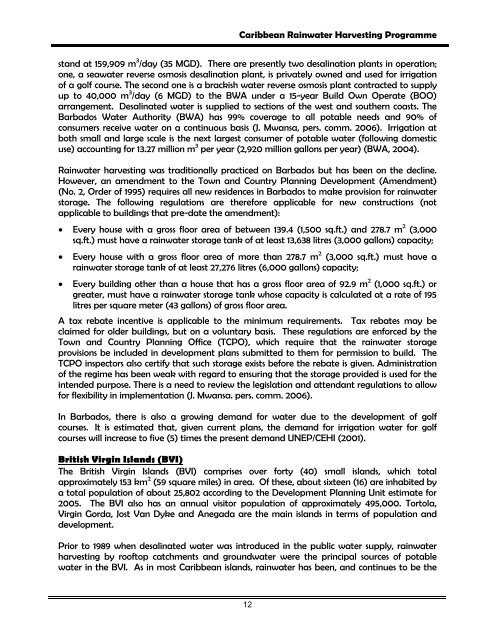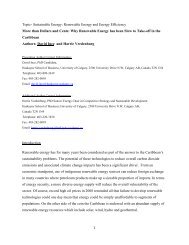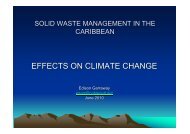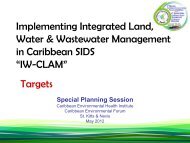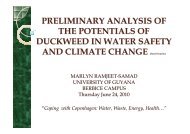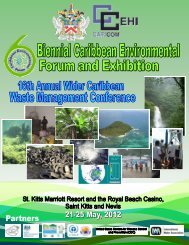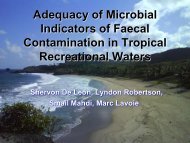A programme for Promoting Rainwater Harvesting in the Caribbean
A programme for Promoting Rainwater Harvesting in the Caribbean
A programme for Promoting Rainwater Harvesting in the Caribbean
Create successful ePaper yourself
Turn your PDF publications into a flip-book with our unique Google optimized e-Paper software.
<strong>Caribbean</strong> <strong>Ra<strong>in</strong>water</strong> <strong>Harvest<strong>in</strong>g</strong> Programmestand at 159,909 m 3 /day (35 MGD). There are presently two desal<strong>in</strong>ation plants <strong>in</strong> operation;one, a seawater reverse osmosis desal<strong>in</strong>ation plant, is privately owned and used <strong>for</strong> irrigationof a golf course. The second one is a brackish water reverse osmosis plant contracted to supplyup to 40,000 m 3 /day (6 MGD) to <strong>the</strong> BWA under a 15-year Build Own Operate (BOO)arrangement. Desal<strong>in</strong>ated water is supplied to sections of <strong>the</strong> west and sou<strong>the</strong>rn coasts. TheBarbados Water Authority (BWA) has 99% coverage to all potable needs and 90% ofconsumers receive water on a cont<strong>in</strong>uous basis (J. Mwansa, pers. comm. 2006). Irrigation atboth small and large scale is <strong>the</strong> next largest consumer of potable water (follow<strong>in</strong>g domesticuse) account<strong>in</strong>g <strong>for</strong> 13.27 million m 3 per year (2,920 million gallons per year) (BWA, 2004).<strong>Ra<strong>in</strong>water</strong> harvest<strong>in</strong>g was traditionally practiced on Barbados but has been on <strong>the</strong> decl<strong>in</strong>e.However, an amendment to <strong>the</strong> Town and Country Plann<strong>in</strong>g Development (Amendment)(No. 2, Order of 1995) requires all new residences <strong>in</strong> Barbados to make provision <strong>for</strong> ra<strong>in</strong>waterstorage. The follow<strong>in</strong>g regulations are <strong>the</strong>re<strong>for</strong>e applicable <strong>for</strong> new constructions (notapplicable to build<strong>in</strong>gs that pre-date <strong>the</strong> amendment):• Every house with a gross floor area of between 139.4 (1,500 sq.ft.) and 278.7 m 2 (3,000sq.ft.) must have a ra<strong>in</strong>water storage tank of at least 13,638 litres (3,000 gallons) capacity;• Every house with a gross floor area of more than 278.7 m 2 (3,000 sq.ft.) must have ara<strong>in</strong>water storage tank of at least 27,276 litres (6,000 gallons) capacity;• Every build<strong>in</strong>g o<strong>the</strong>r than a house that has a gross floor area of 92.9 m 2 (1,000 sq.ft.) orgreater, must have a ra<strong>in</strong>water storage tank whose capacity is calculated at a rate of 195litres per square meter (43 gallons) of gross floor area.A tax rebate <strong>in</strong>centive is applicable to <strong>the</strong> m<strong>in</strong>imum requirements. Tax rebates may beclaimed <strong>for</strong> older build<strong>in</strong>gs, but on a voluntary basis. These regulations are en<strong>for</strong>ced by <strong>the</strong>Town and Country Plann<strong>in</strong>g Office (TCPO), which require that <strong>the</strong> ra<strong>in</strong>water storageprovisions be <strong>in</strong>cluded <strong>in</strong> development plans submitted to <strong>the</strong>m <strong>for</strong> permission to build. TheTCPO <strong>in</strong>spectors also certify that such storage exists be<strong>for</strong>e <strong>the</strong> rebate is given. Adm<strong>in</strong>istrationof <strong>the</strong> regime has been weak with regard to ensur<strong>in</strong>g that <strong>the</strong> storage provided is used <strong>for</strong> <strong>the</strong><strong>in</strong>tended purpose. There is a need to review <strong>the</strong> legislation and attendant regulations to allow<strong>for</strong> flexibility <strong>in</strong> implementation (J. Mwansa. pers. comm. 2006).In Barbados, <strong>the</strong>re is also a grow<strong>in</strong>g demand <strong>for</strong> water due to <strong>the</strong> development of golfcourses. It is estimated that, given current plans, <strong>the</strong> demand <strong>for</strong> irrigation water <strong>for</strong> golfcourses will <strong>in</strong>crease to five (5) times <strong>the</strong> present demand UNEP/CEHI (2001).British Virg<strong>in</strong> Islands (BVI)The British Virg<strong>in</strong> Islands (BVI) comprises over <strong>for</strong>ty (40) small islands, which totalapproximately 153 km 2 (59 square miles) <strong>in</strong> area. Of <strong>the</strong>se, about sixteen (16) are <strong>in</strong>habited bya total population of about 25,802 accord<strong>in</strong>g to <strong>the</strong> Development Plann<strong>in</strong>g Unit estimate <strong>for</strong>2005. The BVI also has an annual visitor population of approximately 495,000. Tortola,Virg<strong>in</strong> Gorda, Jost Van Dyke and Anegada are <strong>the</strong> ma<strong>in</strong> islands <strong>in</strong> terms of population anddevelopment.Prior to 1989 when desal<strong>in</strong>ated water was <strong>in</strong>troduced <strong>in</strong> <strong>the</strong> public water supply, ra<strong>in</strong>waterharvest<strong>in</strong>g by rooftop catchments and groundwater were <strong>the</strong> pr<strong>in</strong>cipal sources of potablewater <strong>in</strong> <strong>the</strong> BVI. As <strong>in</strong> most <strong>Caribbean</strong> islands, ra<strong>in</strong>water has been, and cont<strong>in</strong>ues to be <strong>the</strong>12


